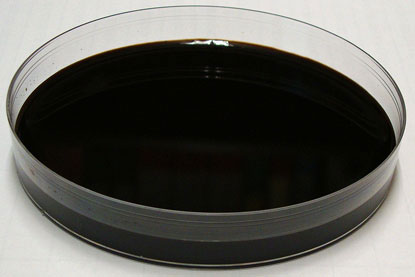N 5
VEGETAL ORIGIN
It is an organic fertilizer derived exclusively from vegetal origin, with nutritional and phytostimulant action; it is obtained from selected fermentation processes.
It has high content of dry matter and a very low level of ashes.
- It feeds plants and supplies high amounts of free essential aminoacids, peptones, nucleic acids and natural chelates.
- It increases the activity of natural auxins, provides full plant growth in every critical situation and stimulates root system growth.
- It fosters better nutrient uptake.
ILSAVEGA has to be used in fertigation. It prevents nutritional stresses. Its use stimulates the development of the microorganisms in soil, crop growth and improves production quality while reducing production waste.
COMPOSITION
-
Total Nitrogen (N) 5 %
- Of which: Organic Nitrogen (N) 5 %
- Organic Carbon (C) 22 %
- Organic material with nominal molecular weight <50 kDa >30 %
- pH 8,7 +- 0,5
- DENSITY 1,18 +- 0,02 kg/dm3
- CONDUCTIVITY E.C. 0,90 +- 0,20 dS/m
Doses and methods of use of the fertilizer
-
Citrus
-
Chinotto15-30 kg/haEvery 10 to 15 days from pre-flowering to veraison
-
Clementine15-30 kg/haEvery 10 to 15 days from pre-flowering to veraison
-
Grapefruit15-30 kg/haEvery 10 to 15 days from pre-flowering to veraison
-
Lemon Tree15-30 kg/haEvery 10 to 15 days from pre-flowering to veraison
-
Mandarin15-30 kg/haEvery 10 to 15 days from pre-flowering to veraison
-
Orange Tree15-30 kg/haEvery 10 to 15 days from pre-flowering to veraison
-
-
Fruit
-
Kiwi15-30 kg/haEvery 10 to 15 days from pre-flowering to veraison
-
-
GrapeVine
-
All10-30 kg/haEvery 10 to 15 days from pre-flowering to veraison
-
-
Greens and Nurseries
-
Ornamental and Floral Crops20-40 kg/ha2-4 applications every 8-10 days in full vegetative development
-
Ornamental and Forest Nurseries20-30 kg/ha2-4 applications every 8-10 days from 10 days after transplanting
-
-
Leafy vegetables
-
Artichoke10-30 kg/haFrom early vegetative development
-
Basil10-30 kg/haFrom early vegetative development
-
Beet10-30 kg/haFrom early vegetative development
-
Chicory10-30 kg/haFrom early vegetative development
-
Chicory10-30 kg/haFrom early vegetative development
-
Endive10-30 kg/haFrom early vegetative development
-
Lettuce10-30 kg/haFrom early vegetative development
-
Parsley10-30 kg/haFrom early vegetative development
-
Spinach30-70 kg/haFrom early vegetative development
-
-
Olive Tree
-
All15-30 kg/haEvery 10 to 15 days from pre-flowering to veraison
-
-
Pome fruits
-
All15-30 kg/haEvery 10 to 15 days from first vegetative phases to formed fruit
-
-
Stone fruits
-
Almond15-30 kg/haEvery 10 to 15 days from first vegetative phases to formed fruit
-
Apricot15-30 kg/haEvery 10 to 15 days from first vegetative phases to formed fruit
-
Cherry15-30 kg/haEvery 10 to 15 days from first vegetative phases to formed fruit
-
Nectarine15-30 kg/haEvery 10 to 15 days from first vegetative phases to formed fruit
-
Peach15-30 kg/haEvery 10 to 15 days from first vegetative phases to formed fruit
-
Plum10-30 kg/haEvery 10 to 15 days from first vegetative phases to formed fruit
-
-
Vegetables
-
Asparagus20-40 kg/haEvery 8 to 10 days from transplant to full production phase
-
Beetroot10-30 kg/haFrom early vegetative development
-
Brussels sprouts10-30 kg/haFrom early vegetative development
-
Carrot20-40 kg/haEvery 8 to 10 days from transplant to full production phase
-
Cauliflower10-30 kg/haFrom early vegetative development
-
Celery20-40 kg/haEvery 8 to 10 days from transplant to full production phase
-
Courgette20-40 kg/haEvery 8 to 10 days from transplant to full production phase
-
Cucumber / Gherkin20-40 kg/haEvery 8 to 10 days from transplant to full production phase
-
Eggplant20-40 kg/haEvery 8 to 10 days from transplant to full production phase
-
Fennel20-40 kg/haEvery 8 to 10 days from transplant to full production phase
-
Leek20-40 kg/haEvery 8 to 10 days from transplant to full production phase
-
Melon15-30 kg/ha2-3 applications, every 8-10 days, during the early stages
-
Pepper20-40 kg/haEvery 8 to 10 days from transplant to full production phase
-
Processing Tomato20-40 kg/ha2-4 applications every 8-10 days in full vegetative development
-
Radish20-40 kg/haEvery 8 to 10 days from transplant to full production phase
-
Savoy Cabbage10-30 kg/haFrom early vegetative development
-
Spring Cabbage10-30 kg/haFrom early vegetative development
-
Strawberry20-40 kg/ha2 to 3 applications every 10 to 15 days during rooting and after the vegetative recovery at the end of harvest
-
Tomato20-40 kg/haEvery 8 to 10 days from transplant to full production phase
-
Turnip20-40 kg/haEvery 8 to 10 days from transplant to full production phase
-
Turnip Tops10-30 kg/haFrom early vegetative development
-
Watermelon15-30 kg/ha2-3 applications, every 8-10 days, during the early stages
-
Dosages are purely indicative and may vary depending on pedoclimatic conditions and average yields expected.













.png)
















